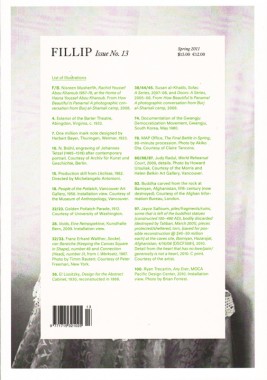
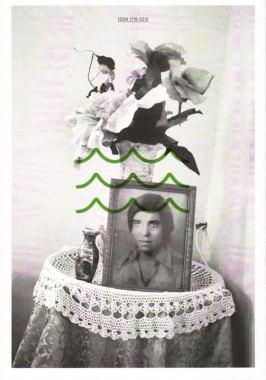
fillip 13, Intangible Economies
Softcover, 116 pp., offset 4/1, 170 x 245 mm
Edition of 2000
ISSN 1715-3212
Published by Fillip
$15.00 ·
Fillip 13 introduces
Intangible Economies, a new, ongoing series broadening the notion of economy beyond its financial dimensions. The series focuses on the multifarious forms of exchange fuelled by affect and desire, speculatively investigating the fundamental role these affective transactions play in modes of representation and, accordingly, in cultural production.
This issue includes series texts by Candice Hopkins, Jan Verwoert, and series editor Antonia Hirsch. Forthcoming installments will include contributions by Hadley+Maxwell, Olaf Nicolai, and Monika Szewczyk, among others.
The issue also features a record of The AAAARG Library, a site-specific installation commissioned for Fillip 13 and the 2010 NY Art Book Fair. The Library, produced by artist Sean Dockray and curated by Jeff Khonsary, will be presented again this summer as part of Night Market, a Red76 project for the Massachusetts Museum of Contemporary Art in North Adams, MA.
AAAARG Library, Anthony Downey, Antonia Hirsch, Art, Candice Hopkins, Carson Chan, Claire Tancons, Criticism, Distribution, Fillip, Hadley+Maxwell, Haema Sivanesan, Jan Verwoert, Jeff Khonsary, Jesse McKee, Kristina Lee Podesva, Lisa Marshall, Massachusetts Museum of Contemporary Art, Monika Szewczyk, Olaf Nicolai, Red76, Ryan Trecartin, Sean Dockray, Theory
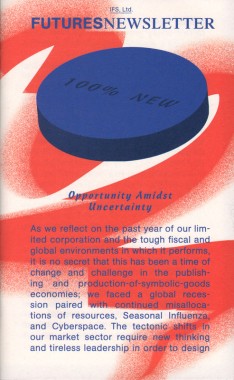
IFS, Ltd. Futures Newsletter, Opportunity Amidst Uncertainty
Softcover, 28 pp., offset 4/4, 110 x 175 mm
Edition of 6000
Published by IFS, Ltd. / Graphic Magazine
free* · out of stock
*free copy with each order
IFS, Ltd. Futures Newsletter is, in non-equal parts: a corporate bulletin, a speculative trading instrument, an experiment in memetic and symbiotic publishing, an internal-external analysis of company performance (B. Critton, H. Gassel, B. Griffiths, Z. Klauck, M. Nguyen), a proposal for an allegorical Escape Act (
S. Dockray), a bid for a series of six activities (
D. Horvitz), an abridged catalogue of semi-fictional gemstones (
L. Francescone), a profile of independent art book distributor (
Textfield, Inc.), and a self-reflexive / -reflective cartoon caption contest (
R. Rozendaal).
Investment Futures Strategy, Ltd. (United States) in partnership with GRAPHIC magazine (Korea) is pleased to introduce Futures, a semi-official newsletter published as a stand-alone supplement to GRAPHIC #17 (”When Design Becomes Attitude”). In lieu of a traditional contribution, IFS, Ltd. has chosen to use the GRAPHIC platform to continue its experiments in trade and publishing.
The Book Trust Prospectus examined new possibilities for funding, trade value, and distribution by attaching a different kind of significance to the object, thus short-circuiting the expected monetary transaction. Production of the Prospectus, however, relied on labor-intensive methods that required hours of input for a relatively small output. With the Futures newsletter, IFS, Ltd. has hybridized the positive aspects of large-scale corporate publishing — economies of scale or large print-runs, distribution of labor, and maximum efficiency — with the dictatorial authorship afforded by self-publishing. This new model maximizes potential as authors and designers while minimizing the opportunity cost of production and distribution.
Within the logic of IFS, Ltd. Futures will also act as a form of currency: readers can use their copy of the newsletter to trade for a copy of the Book Trust Prospectus. These recirculated copies of Futures will then be re-made available as a way to generate revenue for a future, freely distributed, as-yet-undefined project thus continuing the self-sustaining eco-system of publishing and distribution, one in which readers and producers collaborate to generate and circulate content outside of the cost-prohibitive channels of traditional publishing.
Art, Benjamin Critton, Brendan Griffiths, David Horvitz, Design, Distribution, Futures Newsletter, Graphic Magazine, Harry Gassel, IFS Ltd., Interview, Jonathan Maghen, Lauren Francescone, Lim Kyung Yong, Mylinh Nguyen, Na Kim, Nanette Sullano, Phil Chang, Rafael Rozendaal, Sean Dockray, Textfield, The Book Prospectus, Zak Klauck
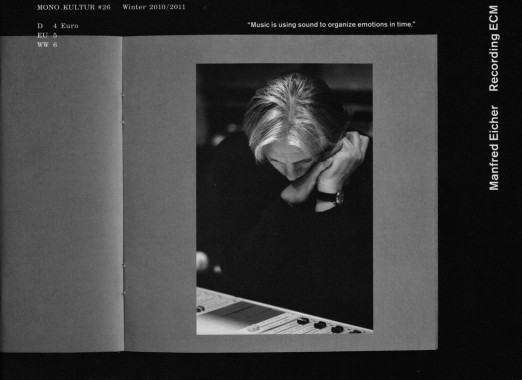
Mono.Kultur 26, Manfred Eicher — Recording ECM
Softcover, 42 pp., offset 1/1, 200 x 150 mm
Edition of 5000
ISSN 1861-7085
Published by Mono.Kultur
$9.00 · out of stock
Born in 1943 in southern Germany, Manfred Eicher dedicated his life early on to music, learning violin as a child, and studying double bass and classical music at the Academy in Berlin. On parallel tracks, he pursued an equally traditional self-education in jazz: through relatives in America, records bought in G.I. stores,
The Voice of America, listening to Bill Evans at the Village Vanguard, playing double bass in German jazz bands and with visiting musicians including Marion Brown, Leo Smith and Paul Bley.
In 1969, a meeting with the American jazz pianist and composer Mal Waldron led to Eicher’s first impromptu production and official release, Free at Last. The immediate success of the record beckoned for more, encouraging Eicher to move backstage and from then on to dedicate his life to finding and producing new music rather than performing. On the outskirts of Munich, with little financial backing, less strategy and no experience in production or managing a record label, Manfred Eicher launched ECM Records as a platform for jazz, a primarily American phenomenon on its wane.
Bernd Kuchenbeiser, Bill Evans, Caroline Heuer, Cheryl Koralik, Culture, Design, Distribution, ECM Records, Eva Gonçalves, Graphics, Joel Alas, Kai von Rabenau, Leo Smith, Manfred Eicher, Mareike Dittmer, Marion Brown, Mono.Kultur, Music, Paul Bley, Renko Heuer, Urs Bellermann
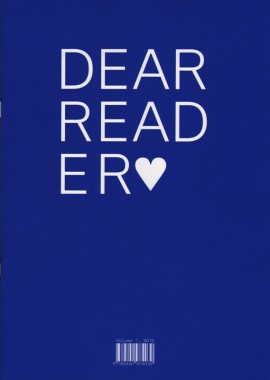
Dear Reader, Vol. 1
Softcover, 36 pp., offset 2/2 + spot varnish, 210 x 297 mm
Edition of 500
ISSN 2211-1085
ISBN 978-94-90974-03-9
Published by Carvalho Bernau
$13.00 · out of stock
A collection of obsessions, oblique references and footnotes of design processes — though not necessarily texts about design. The layout is appropriately diverse and eclectic for the bandwidth of texts, layering different formats and texts, as a tongue-in-cheek reference to the design shtick of publications with different paper formats. Here we present three iconic formats in emphasized-as-fake three-dimensionality, on four different papers and more inks than you would think.
Dear Reader was created partly from a primordial graphic designers’ urge to publish something and to share texts that are dear to us, partly in celebration of Atelier Carvalho Bernau’s approximate fifth anniversary, and partly as a vessel to showcase our type design work in a manner that circumvents the conventions and the visual clichés of the type specimen.
Adolf Loos, AG Fronzoni, Barbara Wright, Carvalho Bernau, Design, Distribution, El Lissitzky, Frederico Duarte, John Cage, Kai Bernau, Morton Feldman, Raymond Queneau, René Hague, Susana Carvalho, Typography
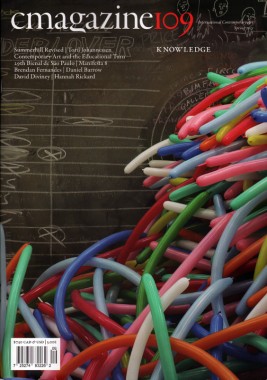
C Magazine 109, Knowledge
Softcover, 56 pp., offset 4/1, 210 x 295 mm
Edition of 2200
ISSN 1480-5472
Published by C Magazine
$7.50 ·
Issue 109 of C Magazine, Knowledge, includes an essay by Jen Kennedy, School’s In: Contemporary Art and the Educational Turn, that examines Jennifer Dalton and William Powhida’s #class, Anton Vidokle’s unitednationsplaza and Night School, and projects recently conducted at the Copenhagen Free University, and a feature article by Sholem Krishtalka, “You and Me and Her and Us and Them: A Conversation on Using and Being Used,” about collaborating with novelist Sheila Heti and painter and filmmaker Margaux Williamson. This issue also includes an interview by Mandy Ginson with Toril Johannessen, exploring some of the ways Johannessen engages scientific methods of analysis and models of classification and display in her work, as well as two artist projects; Summerhill, Revised, by Helen Reed and Hannah Jickling with an accompanying text by Stephanie Springgay, and Studies for Possible Futures by Maggie Groat. Issue 109 also includes reviews of the 29th Bienal de São Paulo and Manifesta 8, as well as book reviews and exhibition reviews from cities including Fredericton, Halifax, Hamilton, Ottawa, Toronto and Vancouver.
Anton Vidokle, Art, C Magazine, Distribution, Hannah Jickling, Helen Reed, Jen Kennedy, Jennifer Dalton, Maggie Groat, Mandy Ginson, Margaux Williamson, Sheila Heti, Sholem Krishtalka, Stephanie Springgay, Toril Johannessen, William Powhida
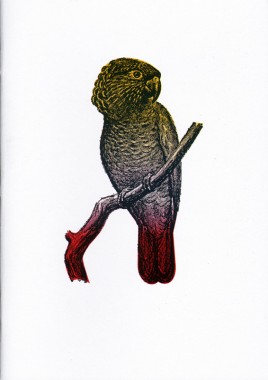
Ginger&Piss 2, Gay
Softcover, 32 pp., offset 1/1, 140 x 200 mm
Edition of 200
ISBN 978-94-90629-03-8
Published by Kunstverein
$21.00 ·
Ginger&Piss is a cross between an academic journal and a darts club newsletter. The journal (falsely quoting Lawrence Weiner) is published twice yearly, and starts off in a limited run. Each issue contains a maximum of 5 or 6 contributions, of any length necessary.
The idea behind Ginger&Piss is to offer an outlet for authors to say what they feel is vital (and not necessarily at all related to the art world). The concept dictates that each contributor writes under a pseudonym. We–the editors–guarantee full privacy. We see the use of pseudonyms as an answer to the cowardice of the art world, be it a somewhat hypocritical answer. By allowing a platform to exist for candid critique but at the same time by still letting the author hide behind a pseudonym, we recognize our own cowardice. In fact, Ginger&Piss fully embraces its somewhat misleading bravery, but we think it makes sense for now, for the current cultural climate.
Gay is the “subject” of the second issue of Ginger&Piss and continues the magazine’s flirtation with all-purpose (non) themes. As a verb and as an expression (and maybe even a curse) Gay may appear less one-dimensional than Loud (Ginger&Piss’ first theme. Flamboyantly exhibited as internal swagger and compulsive paranoia, the articles in this issue continue Ginger&Piss’ journey towards immaculate speculation.
Álvaro Coelho de Athayde II, Art, Coco de Moll, Distribution, Ginger&Piss, Harrison Haymarket, Krist Gruijthuijsen, Kunstverein, Lylah Clare, Marc Hollenstein, Maxine Kopsa, Meredith Morris, R. J. Vanderhorst, T. Gidley, The Mondrian Foundation
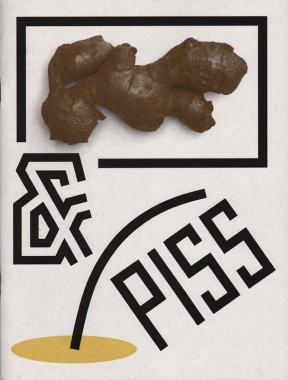
Ginger&Piss 1, Loud
Softcover, 22 pp., offset 4/1, 210 x 275 mm
Edition of 200
ISBN 978-94-90629-03-8
Published by Kunstverein
$21.00 ·
Dear Reader,
Ginger&Piss is Kunstverein’s in-house magazine — a cross between an academic journal and a darts club newsletter. Ginger&Piss (the name a misquotation of Lawrence Weiner) is published twice yearly, with the first edition appearing in a short run. Each issue contains a maximum of five or six contributions of varying length, appropriate to the individual subject matter.
The remit of Ginger&Piss is simple: to offer an outlet for authors to say what they feel is vital (and not necessarily at all related to the art world) but were unable, unwilling or too afraid to publish previously. The concept dictates that each contributor writes under a pseudonym. We — the editors — guarantee full anonymity.
Loud is the subject of the first issue and it is a broad — probably far too broad — theme (if a them at all). In fact Quiet might have been more appropriate. But we at Ginger&Piss think a clear, ‘honest’ voice is better suggested by volume than whispering.
— Krist Gruijthuijsen and Maxine Kopsa
Anonymous, Art, Billy Male, Distribution, Elvira Belafonte, G. Alonso Oeuf, Ginger&Piss, Hula Capellinni, Krist Gruijthuijsen, Kunstverein, Marc Hollenstein, Maxine Kopsa, T. Gidley, The Mondrian Foundation
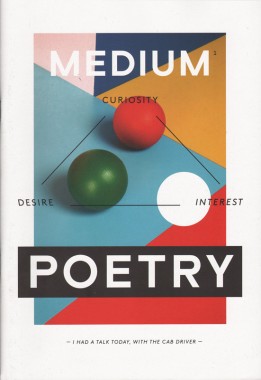
Medium 1, Poetry
Softcover, 64 pp., offset 4/4, 165 x 240 mm
Edition of 500
Published by Nieves
$14.00 · out of stock
Today there was a guy leaning the wrong way in the tube. It was not immediately noticeable. There was no one else sitting nearby. No other passengers to compare him to. But then I did notice that every time the carriage came to a stop, he leaned away from the direction we were moving. Very slightly. Think about it. You’re supposed to lean forward. In the direction you were moving toward. Toward the point which the weight of your body was expecting to reach. Now this guy, he leans the other way. Just slightly. As a friend of mine would put it, he has a great sense of irony. Definitely. That’s important in life. They say that Rothko, he killed himself because he met the people who bought his art. No sense of irony. Me neither I don’t have any sense of irony. I like to take things at face value. Your wife she once told me that what led to the demise of the Black Panthers, aside from the absence of trust, and a murderous governmental incarceration campaign, it was their complete lack of a sense of humor. It was only much later that I realized she meant a murderous governmental incarceration campaign is actually a lot worse than not having a sense of humor. But these ironies are lost on me. Your sister and your wife they both say so. When I tell them things I find funny, they rarely laugh. I’m not even going to mention this guy in the tube to them. I recently told them about my bathroom sink in this hotel room. Real bad design. Flat. Which meant the liquid always accumulated in the corners. Instead of flowing down the drain. You had to use your fingertips to fish out the shaved hair stubble from the corners of the sink. Or it would just lie there. Waiting. You know what’s even funnier: you had to try and propel what you spat out when you brushed your teeth towards the center of the sink. Or you’d have mounds of mucus and toothpaste. Just drying in small heaps, here and there. Hilarious. And speaking of heaps of mucus. Another thing I’ll keep to myself – this was the funniest thing in years: I saw an old couple smooching in the street the other day. How often do you see that. Teenagers, yes. Or oldies arm in arm. But here you had oldies with their tongues down each other’s throats. Right there in the pedestrian zone. Eighty years old maybe more. Couldn’t believe it. I just stood there laughing. These oldies have no sense of humor either. They pretended not to hear me. But I could tell they heard me perfectly well. So now the carriage starts moving again, and I stand up, knowing I’ll exit at the next station. You see there are things I’m less sure about. Are they funny or just poetic. Lately my eyeballs scrunch as I close my eyes. A crunching sound. Brief, almost imperceptible. The sound is a bit like high-tech mechanics when they start aging. Wearing out. A whispering scrunching sound. Funny, or lyrical? Now as I exit the carriage, I notice there’s vapor in the air as I breathe, despite the high temperatures. It’s been like this all week. Again, very odd and almost funny. In a tiny, barely noticeable kind of way. Like the guy leaning the wrong way back there. As the doors slam shut, I turn around to look for him. I want to see which direction he’s leaning in as the train departs. Before I can assess his movements, he smiles and waves. I wave, but I fail to smile back. It’s just not funny anymore.
Art, Bastien Aubry, Culture, Distribution, Hassan Khan, Manuel Krebs, Nieves, Poetry, Samuel Nyholm, Shirana Shahbazi, Tirdad Zolghadr
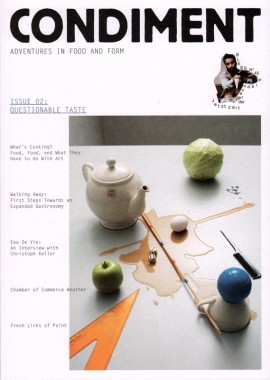
Condiment 2, Questionable Taste
Softcover, 90 pp., offset 4/4, 165 x 230 mm
Edition of 1000
ISSN 1837–8226
Published by Condiment
$18.00 ·
This issue of Condiment has reminded us of the simple truth that we are living with food, not living for food. In this context, the aim shifts from accomplishment to a need for further exploration. Ideas and approaches to food have never seemed so evolved and exaggerated. Yet, as the focus on the meal continues to increase, we risk forgetting about all the hours of living that exist in between. Rather than only being an object of desire, food needs also to be a subject of discussion—approached not as a statement about politics, provenance or proficiency, but as an open-ended question mark. In some form or another, we hope that each page of this issue raises questions —not just about what food is, but about what it can be. After all, each meal is both an outcome and a new beginning.
Produced in collaboration with BLESS. Images from their collection BLESS N° 42, Plädoyer der Jetztzeit appear on each page of the publication.
Amanda Maxwell, Bless, Cameron Allan McKean, Chris Barton, Condiment, Desiree Heiss, Distribution, Elizabeth Bryant, Ellen Birrell, Eva-Fiore Kovacovsky, ffiXXed, Food, Geoff Newton, Ines Kaag, Jessica Brent, Klara Källström, Linus Bill, Misha Hollenbach, Nancy Bale, Riley Payne, Shauna T., Stefan Marx, Taro EF Nettleton, Thobias Fäldt, Thomas Jeppe, Tim J Veling, Uta Eisenreich
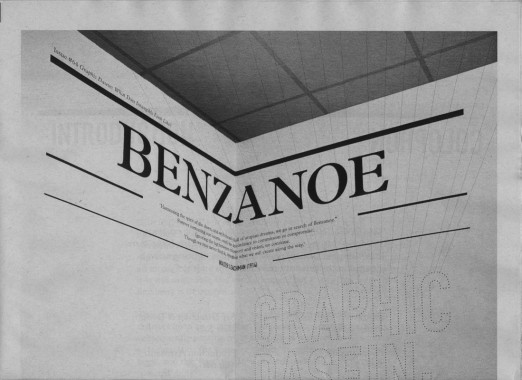
Benzanoe 64, Graphic Dasein*
Newspaper, 12 pp., web offset 1/1, 12.5 x 18 inches
Edition of 100
Published by Benzanoe
$8.00 ·
*
Dasein is the German vernacular term for
existence, it is derived from
da-sein, which literally means
being-there.
“The printed artifact always carries with it belief; under pinned by a historic and cultural relationship between print and truth. Issue 64 deals directly with this concept through a series of install tions, representing the pages of the magazine. The content is delivered through playing with perspective, perception, resolution, view point and production.“
Anders Ekblom, Bryan Clark, Design, Dion Star, Distribution, Dry Carolyn Shapiro, Lizzie Ridout, Martin Heidegger, Mat McIvor, Max Stirner, Steve Tanner, Walter Leachman
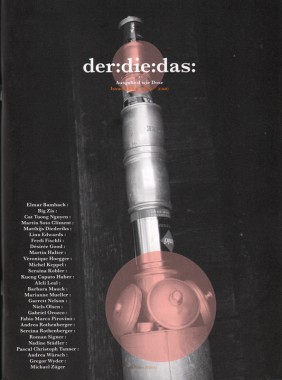
der:die:das:, Issue d like dose (can)
Softcover, 100 pp., offset 4/4, 200 x 270 mm
English and German
Edition of 1000
ISSN 1663-2508
Published by der:die:das:
$22.00 ·
Some words on, and images of, dose (can).
Aleli Leal, Andrea Rothenberger, Andrea Wursch, Art, Barbara Mauck, Big Zis, Cat Tuong Nguyen, Culture, der:die:das:, Desiree Good, Distribution, Elmar Bambach, Fabio Marco Pirovino, Fredi Fischli, Gabriel Orozco, Garrett Nelson, Gregor Wyder, Kueng Caputo Huber, Linn Edwards, Marianne Mueller, Martin Halter, Martin Soto Climent, Matthijs Diederiks, Michael Zuger, Michel Kobler, Nadine Stadler, Niels Olsen, Pascal Christoph Tanner, Photography, Roman Signer, Sereina Rothenberger, Veronique Hoegger
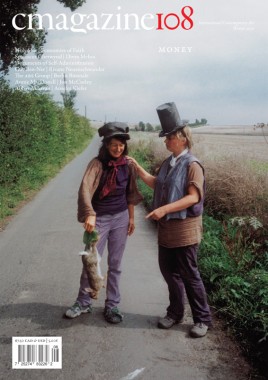
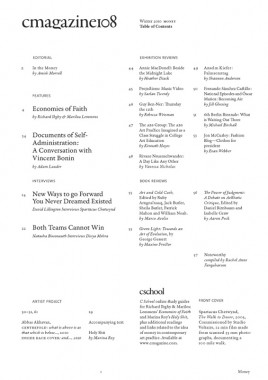
C Magazine 108, Money
Softcover, 64 pp., offset 4/1, 210 x 295 mm
Edition of 2200
ISSN 1480-5472
Published by C Magazine
$7.50 ·
C Magazine issue 108
Money includes an artist project by Abbas Akhavan, where he has inserted a sheet of imitation gold leaf in each of 2,200 copies of C Magazine. Also available are 25 special limited edition magazines with gold leaf, signed and numbered by the artist.
Feature articles in issue 108 include Economies of Faith, by Richard Ibghy and Marilou Lemmens, looking at works by Mark Boulos, Melanie Gilligan and Olivia Plender that explore the relationship between the workings of the market and the spiritual belief, and Documents of Self-Administration: A Conversation with Vincent Bonin, by Adam Lauder, about the exhibition Documentary Protocols at the Leonard & Bina Ellen Gallery. This issue also includes interviews with British artist Spartacus Chetwynd, by David Lillington, and Canadian artist Divya Mehra, by Natasha Bissonauth.
Reviews include Shannon Anderson on Anselm Kiefer’s Palmsonntag at the Art Gallery of Ontario; Saelen Twerdy on Projections: Music Video at Musée d’art contemporain de Montréal; Kenneth Hayes on Group ABS at Gallery Siz in Rijeka, Croatia; Vanessa Nicholas on Rivane Neuenschwander’s A Day Like Any Other at the New Museum; Heather Diack on Annie MacDonell’s Beside the Midnight Lake at Katharine Mulherin Contemporary Art Projects; Rebecca Weisman on Guy Ben-Ner: Thursday the 12th at Mass MoCA; Jill Glessing on Fernando Sánchez Castillo: National Episodes and Óscar Muñoz: Becoming Air at Círculo de Bellas Arte, Madrid; Michael Birchall on the 6th Berlin Biennale; and Evan Webber on Jon McCurley: Fashion Blog — Clothes for President.
Abbas Akhavan, Adam Lauder, Annie MacDonell, Anselm Kiefer, Art, C Magazine, David Lillington, Distribution, Divya Mehra, Evan Webber, Fernando Sánchez Castillo, Guy Ben-Ner, Heather Diack, Jill Glessing, Jon McCurley, Katharine Mulherin, Kenneth Hayes, Marilou Lemmens, Mark Boulos, Melanie Gilligan, Michael Birchall, Money, Natasha Bissonauth, Olivia Plender, Óscar Muñoz, Rebecca Weisman, Richard Ibghy, Rivane Neuenschwander, Saelen Twerdy, Shannon Anderson, Spartacus Chetwynd, Vanessa Nicholas, Vincent Bonin
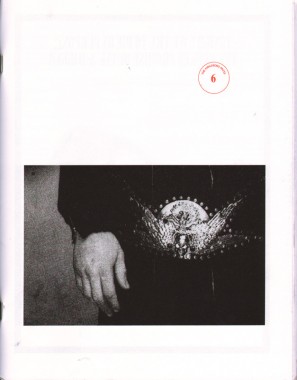
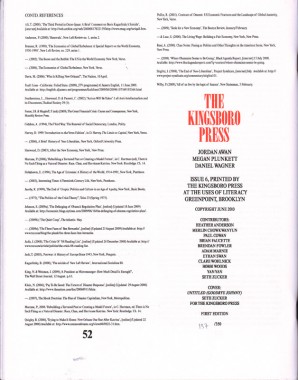
The Kingsboro Press 6
Softcover, 52 pp., mimeograph 3/1, 8.5 x 11 inches
Edition of 350
Published by The Kingsboro Press
$20.00 ·
Issue 6 of The Kingsboro Press, mimeograph printed by The Kingsboro Press at The Uses of Literacy in Greenpoint, Brooklyn. Contributors: Heather Anderson, Merlin Chowanyun, Paul Cowan, Brian Faucette, Brendan Fowler, Adam Marnie, Ethan Swan, Clare Wohlnick, Bobbi Woods, Yan Yan, Seth Zucker.
Adam Marnie, Art, Bobbi Woods, Brendan Fowler, Brian Faucette, Clare Wohlnick, Daniel Wagner, Distribution, Ethan Swan, Heather Anderson, Jordan Awan, Megan Plunkett, Paul Cowan, Seth Zucker, The Kingsboro Press, The Uses of Literacy, Yan Yan















